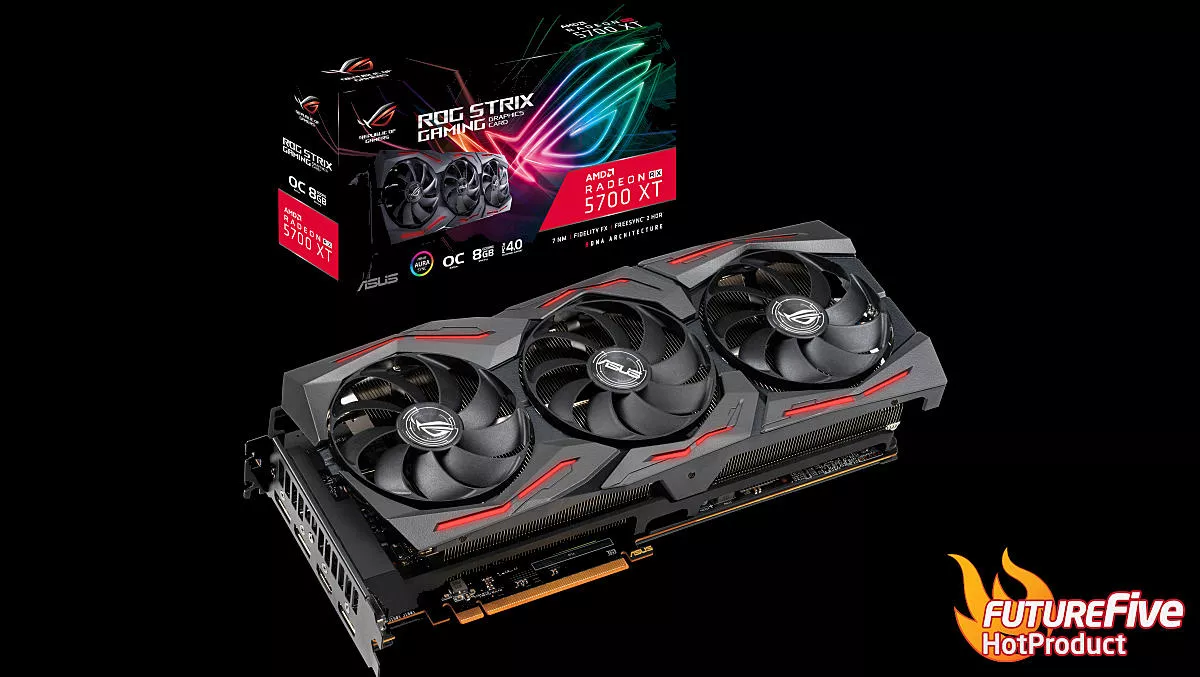
Hands-on review: ROG-STRIX-RX5700XT-O8G-Gaming GPU
Are you team red (AMD) or team green (NVIIDIA)? For generations, team green has dominated the leader board of PC gaming graphics beyond 1080p resolution, while team red focuses on the development of better gaming experience for console gamers. For PC gamers, the AMD brand has been somewhat recognised as the budget alternative for quite some time. The game has actually changed with the introduction of the Navi GPU, based on AMD's latest RDNA architecture.
What we have in the lab today is ASUS's ROG STRIX variance of the RX5700XT, currently the fastest Navi processor available to date. The Navi family is the first desktop GPU manufactured with the latest 7nm production by TSMC for the effective reduction of power draw and current leakage. This essentially makes the GPU cooler, giving it more headroom against its 12nm rivals.
For a fair and accurate review, we have specially requested ASUS to sample us with the new PSI updated screw fitting and VBIOS, intended to improve thermal transfer and game compatibility. All existing stock in New Zealand should feature these updates.
Like any other ROG STRIX graphics card we have reviewed in the past, the ROG-STRIX-RX5700XT-O8G-GAMING is equipped with Super Alloy Power II. This is a premium power solution based on top-notch power components such as DrMOS power stages, Alloy Choke and premium solid capacitors. Providing stable power at extremely high efficiency, adding OC headroom while minimising heat generation.
The card is precisely manufactured using ASUS's Auto-Extreme Technology, where no human is involved in the production cycle, allowing the completion of all soldering work within one single phase. This not only reduces thermal strain on components, but it also avoids the use of harsh cleaning chemicals while lowering manufacture power consumption. This reduces environmental impact, at the same time as minimising chances of a manufacturing defect.
In order to provide adequate cooling for the 225W RX5700XT GPU, ASUS has thrown in what is the biggest cooler we have seen. A 2.7 slot thick heatsink that uses a super finely polished MaxContact copper base, and through the massive 6-heat pipes to quickly bring the heat away from the GPU. The heat is then passed on to the massive array of aluminium fins, and cooled by the three Axial-Tech fans, a special breed of fans that provides additional air pressure.
Four GPU spring screws are in place to secure this heavy heatsink on the GPU for an optimal cooling result. Two additional step screws also used in this design to balance the weight spread of this heavy heatsink along the card. Ensuring even contact across the entire surface of the GPU. Also due to the weight added up from the extensive metal used on that cooler, a metal-reinforced frame is also included to prevent the card sagging when mounted horizontally.
In terms of special features, the Navi GPU is equipped with a good collection of game image enhancement features such as Radeon Image Sharpening, FidelityFX, Radeon Anti-Lag and FreeSync2. ASUS also added dual VBIOS on the card. You can easily switch between two complete set of power and fan profiles via a quick flip of a switch.
There are two additional Fan Connect II connectors on the side for front chassis fans to operate responding to the change of GPU temperature. There is even a 4-pin 12V RGB header if your motherboard lacks such connector for your chassis. You can even turn off all the RGB lightings on the card via a quick press of the sheath button at the back of the card if you are not a fan of fancy lighting.
The gaming performance is very attractive. We easily pumped out over 60 frames on AAA titles such as Battlefield V, Far Cry 5, Metro Exodus and Sekiro at max graphical setting over 1440p. In fact, even after jacking up the resolution to 2160p, we were able to achieve close to 60 frames in most titles we have tested with the same setting. Well done AMD, it is comparative to a RTX2070. For the first time in generations, the SKU naming between team red and team green do line up.
Testing the GPU temperature, the GPU idles down to around 35 degrees both Tjunction and Tcase in our 20 degrees lab room temperature inside a case with the card horizontally mounted. After stressing it with a few sessions of games, it peaks to 86 degrees Tjunction, 65 degrees Tcase. The delta between the two being under 20 degrees indicates the GPU is in perfect and even contact with the cooler.
Based on the data from ASUS, the power target of the card being 90 degrees Tjunction, this simply means the card still has room to boost further. It is also worth mentioning that the fan ratio has not exceeded over 62% of its peak RPM, the card remains whisper-quiet for the entire duration of our test. A very remarkable result indeed.
Based on the price from PriceSpy, the ROG-STRIX-RX5700XT-O8G-GAMING is 20% cheaper than its RTX2070 variance. The addition of Radeon Anti-Lag and FreeSync2 also helps to pull in the gap of the gaming experience between the two. Moreover, it also features exclusives such as Radeon Image Sharpening and FidelityFX that makes the game image simply look better at the same resolution.
AMD definitely puts many goodies on the table, making the RX5700XT hard to resist, and it is hard for us not to recommend it to our readers. If you are a diehard member of team red, or still juggling between going to with either team red or green, give the ROG-STRIX-RX5700XT-O8G-GAMING a try, you won't regret it.

